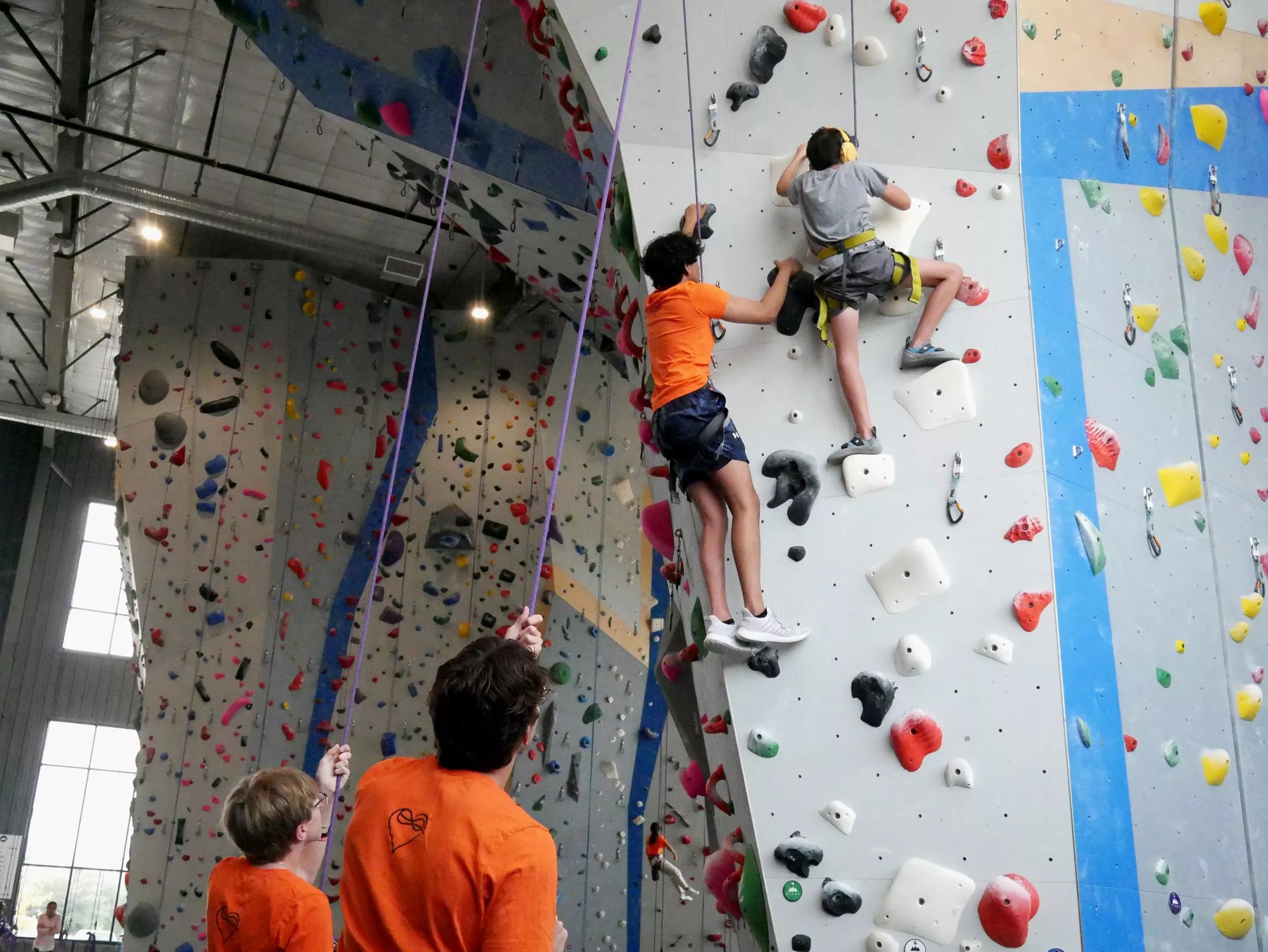
Jack Moraglia

Audio By Carbonatix
“I’m scared,” says Jacob Shaffstall, clinging to the climbing wall 15 feet above the ground. He’s a skinny 10-year-old with yellow headphones on the wall at Movement Gym in Grapevine.
“Jacob, I’ve got you,” says one of the three young men helping him climb, attached to the belay supporting Jacob.
“We won’t let you fall,” says another. The third climbs close to Jacob, pointing to the next hold to shoot for. Jacob stretches out and grabs it, hoisting himself up. “I’m ready to come down now.” He pushes off the wall and slowly swings down to the sound of encouraging words.
Jonah Shaffstall, just 4 years old and Jacob’s brother, makes his way up the wall only 10 feet, but many times his height. His mom, Amanda Shaffstall, holds her arms up to support his legs, more for comfort than anything: the volunteer belaying him won’t let him fall. Jonah grabs bright-colored rubber worms at each checkpoint. They guide him and act as mini rewards with each step.
“Rock climbing has brought sunshine to our week,” Amanda says. Days ago, a fire destroyed the Shaffstalls’ home. Everyone got out safely. They’ve been living in a temporary apartment.
“We just kept saying, ‘We have climbing this week, we have climbing,'” Shaffstall said. The climbing is thanks to United Rocks, an organization that has been a lighthouse guiding the family in from choppy seas in recent times. The local nonprofit helps individuals, mostly kids, with intellectual and developmental disabilities (IDD) rock climb in a safe, community-oriented environment.
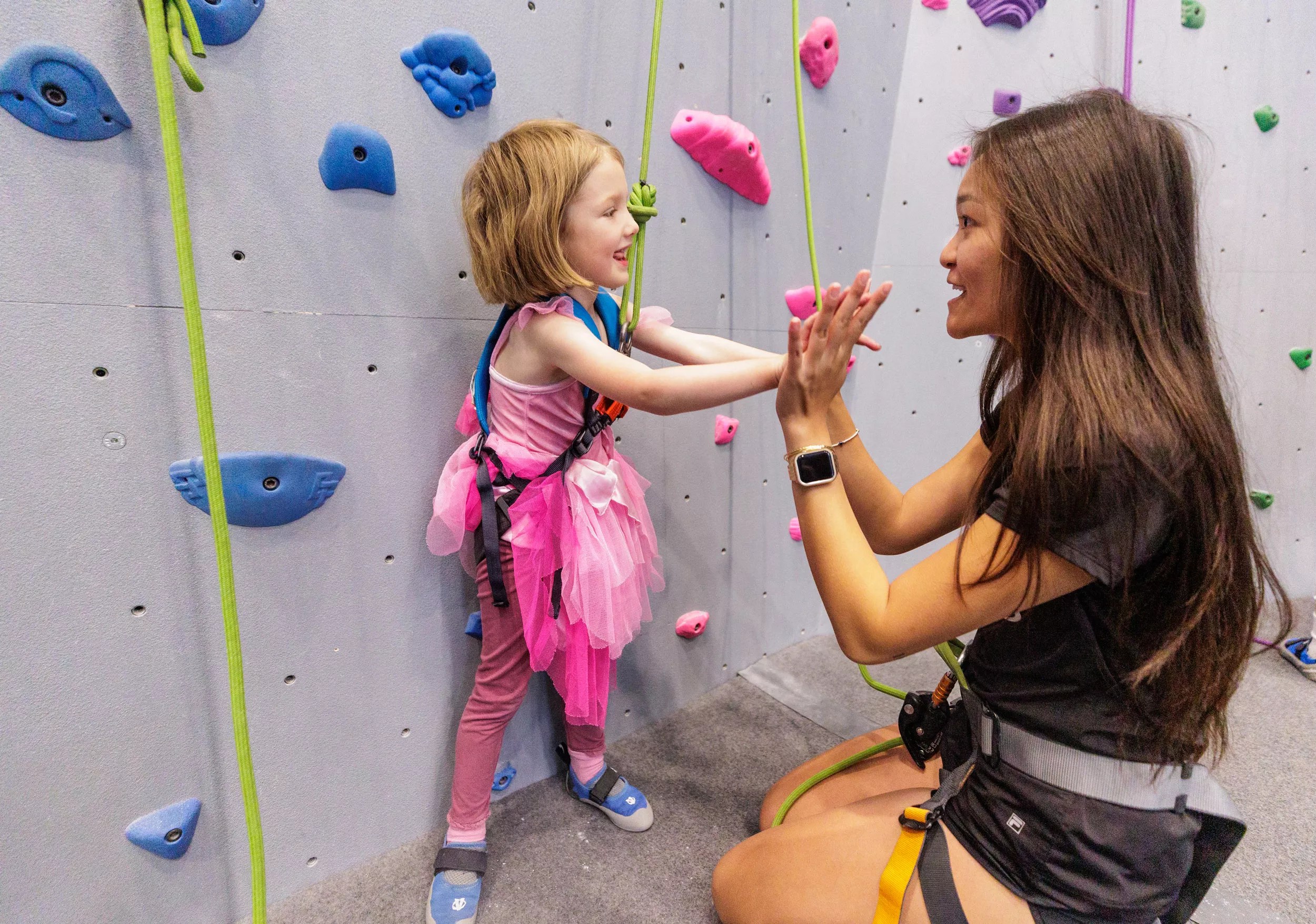
Luna Silvestri, 5, exchanges high fives with Julia Moua.
Nathan Hunsinger
‘Nobody’s Doing This’
The walls at Dyno-Rock in Arlington are covered in polyurethane holds, many shaped like animals and dinosaurs. The first climber hasn’t yet clipped in as Mariana Steelsmith and her volunteers wait for the start of another United Rocks Sunday morning practice. As families walk in, Steelsmith welcomes each one with high fives and big smiles. She has short brown hair and wears bright blue leggings printed with hibiscus flowers and Stitch, the alien character from Lilo & Stitch.
Steelsmith and her husband, Brian, started United Rocks in 2021. There are more than 500,000 individuals with IDD in Texas that could benefit from programs like theirs. The Steelsmiths’ oldest son, Gabriel, 22, used to compete nationally at rock climbing. “We love the sport. We love the community, the coaches, the peers; everybody was very influential with my oldest son.”
The Plano family’s second son, Jake, was born with Down syndrome. The family wanted to ensure Jake, 16 years younger than Gabriel, had the same opportunities their oldest son enjoyed.
“I started researching about who’s doing this, creating teams for kids with disabilities,” Mariana says. “And it turned out that nobody’s doing this.” She decided to do it herself. “Jake with a disability and Gabriel with the climbing experience, we basically combined both of them and just created something that wasn’t there for them.”
“Rock climbing has brought sunshine to our week.” – Amanda Shaffstall
Now, United Rocks has had almost 500 volunteers and 150 kids participating in the program.
Mariana started practices with five families at a gym in Plano. Slowly, more people began showing up, and the organization grew to locations in Grapevine, Arlington and the Design District in Dallas. Now, United Rocks is opening outside of Texas in Englewood, Colorado, and Crystal City, Virginia.
In March, the Steelsmiths traveled to Englewood for an expansion event, where 13 kids climbed with 30 volunteers participating. Weekly practices at the Englewood facility will start in May or June.
“Eventually we want to go everywhere,” Mariana says. “Every gym that has a top rope in the U.S., we want to have a team there.”
Cross-country expansion wasn’t always in the cards for the Steelsmiths. “Let’s start a climbing thing for kids with IDD and see what happens,” is what Mariana thought in the beginning stages. “Two years in, this is what happened.”
Above the Comfort Zone
The volunteers group up for a pre-practice meeting, going over expectations and which volunteers and kids to pair. The volunteers wear orange shirts, while the head coach and official coordinators wear blue. Everyone has a name tag or their name Sharpied into their shirt.
A clipboard tracks each kid’s progress: what has worked in the past, how they’ve improved, who they’ve been paired with.
Individualized tracking is important because “each kid is so different. What works for one might not work for another,” says Sadie Burt, head coach at the Grapevine Movement location. She has been coaching for about two years. Dyno-Rock in Arlington is head coached by Katie Rogers, a junior special education major at UT Arlington, who has two months of coaching under her belt. Both coaches bounce around to each kid during practice to keep things moving smoothly.
As volunteer coordinator, Kevin Cuadrado is responsible for pairing Grapevine volunteers with participants. Climbers can get very attached to having the same volunteer every time. Sometimes that’s a good thing, and sometimes Kevin likes to push kids out of their comfort zones by changing things up.
When the climbers arrive, everyone circles up for warmups, led by Sadie and Katie at their respective gyms. There are the standard leg and arm stretches, plus some climber-specific hand and finger stretches. Everyone flicks their fingers out “like you’re flicking water off your hands.”
Some parents participate with their children, while others take a much-needed break after getting the family out on a Sunday morning. Amanda Shaffstall sits with Jonah, shifting his legs into position, while keeping an eye on Jacob and making sure he pays attention.
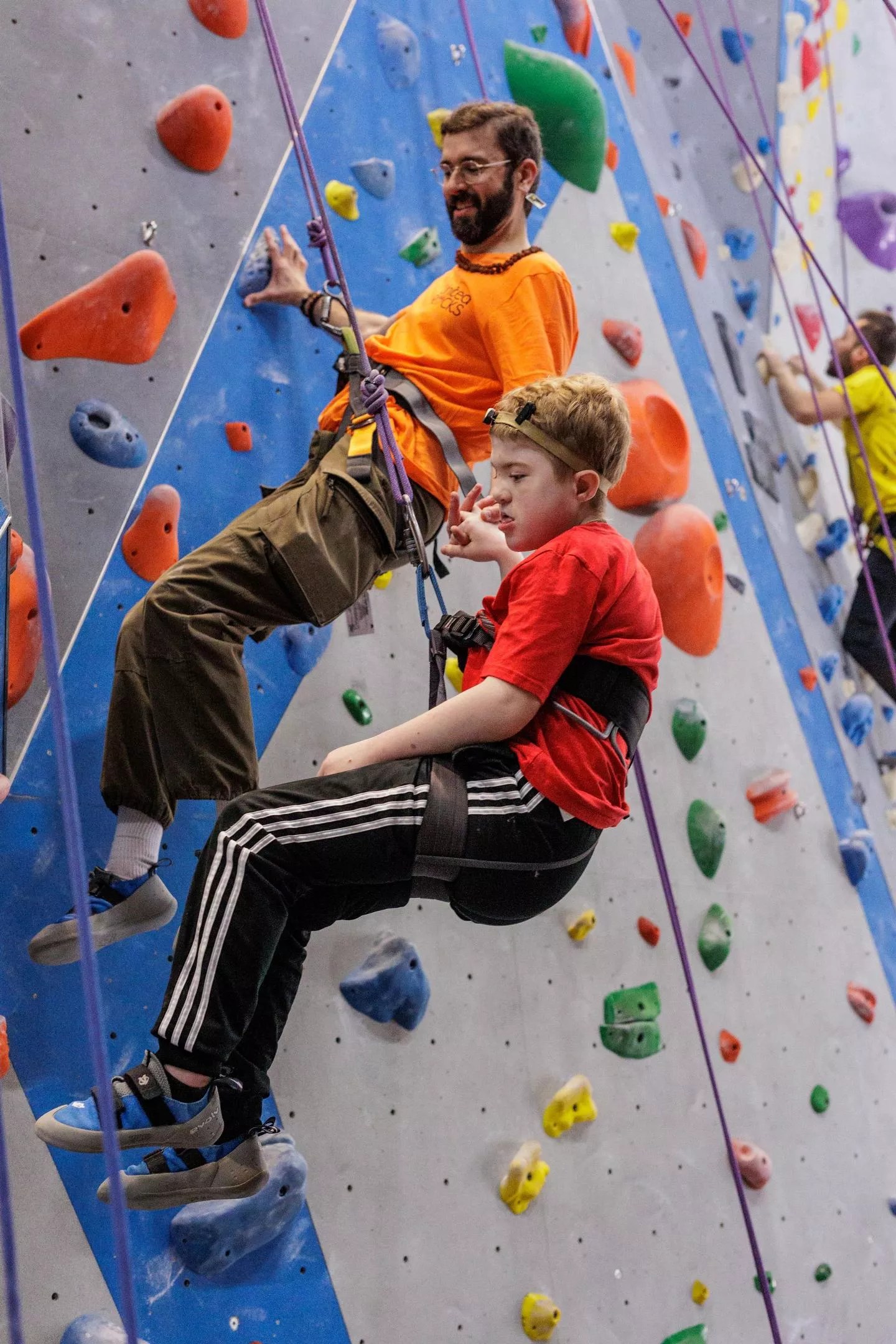
Volunteer Pete Glaze assists George Donnelly, 10, in climbing the wall.
Nathan Hunsinger
Helpful Challenges
Brian Steelsmith, Mariana’s husband and co-founder of the organization says the biggest question the kids have is why? “Why do I climb? Why do I go up there?”
Of course, they don’t ask this question at home. At home, they climb all over the couch, the counters, the stairs and their railings. United Rocks helps channel kids’ innate love for climbing into something productive.
Jake used to follow Brian up the ladder. Each time he needed to change a lightbulb or dust a fan, Jake’s little legs and arms ambled right up after him. OK, he thought, here’s something he likes to do.
Fast forward a few months, and Jake was climbing a 60-foot wall, incentivized by a Hot Wheels car waiting at the top.
Mark Brown is another kid who climbed on everything at home. Once they got to the wall, “it took him a while to figure out the goal of it,” his mom, Tara Brown says. One thing the 11-year-old with autism loves is numbers. So, they tried something out.
Mark counts each step as he climbs, and the volunteers join in. “1, 2, 3, 4, 5,” everyone shouts at him from below as he moves his arms up the route.
“Good job! Five more?” Tara wills. Mark goes five more.
Finding what a kid with disabilities likes to do isn’t always easy. “It’s still a puzzle for me to try to figure out what my son really likes,” says Nicole Le, whose 12-year-old son Aaron Tong has autism and speech impairment. Tong has been attending United Rocks in Grapevine for the better part of a year.
“At first, I didn’t see how beneficial the potential was going to be when we first tried it out. But the more I take him to practice, the more I realize this is it,” Le says. “This is one sport that combines many, many different challenges that help my son.” Le says climbing has helped Aaron’s thinking process, muscle memory, fine motor skills and arm and leg strength.
Cost became an issue for Le, who told Mariana she could not afford to bring her son anymore. The first month of practice is free, and after that the organization asks for a $60 a month donation. “I was going to withdraw Aaron, which is not something that I wanted to do,” Le says.
But Mariana saw the boy’s growth, the improvement in his strength and ability. She offered a sponsorship for him to keep coming for free.
“We see the commitment that parents have with their kids to come and climb, so we don’t want to turn them away just because they have the extra cost,” Mariana says.
A grant from the Jordan Spieth Family Foundation is helping cover some of the costs of expansion, climbing gear and sponsorships like the one Aaron has.
Parenting a special needs child is far from merely the fun and games that rock climbing on the weekends may bring. Taking special needs kids into public settings can be frustrating for parents. Families often retreat when faced with the looks and stares of others when their child won’t be quiet or can’t quite sit still at the restaurant. Oftentimes it’s simply easier to burrow into their homes. Let’s just order takeout. Why bother with the hassle?
Brian Steelsmith has ruminated a lot on the state of mind of parents like him. “Kids with special needs are a handful,” he says. Each word he speaks is heavy with weight, delivered slowly with intention. He wears a blue North Face beanie and a thick gray-black beard, with no shoes on the soft ground. If you didn’t hear his soft voice and friendly tenor, you might be intimidated by him.
“Parents with kids with special needs have the tendency to harbor them away,” he says. “They don’t take them out. It’s a handful to go out on our own with the anxiety in our world. To take that kid with you is exponentially harder.”
Brian’s direct, to-the-point personality contrasts Mariana’s whirlwind, fast-paced chatter, colored by her Peruvian accent. But both share the same goal and thesis.
“We take him everywhere,” Mariana says about Jake. “I don’t care that he has a disability. I don’t care at all, right? We take him everywhere. But there’s some parents that I see that they’re a little bit… Hey, where are you going? Hey!” Our interview is paused as Mariana darts up to chase Jake, who’s running away from the climbing area toward the bathroom. No matter where her focus is, she never loses sight of her child.
The point she was making was that there can be guilt and shame thrust on parents when they bring their special-needs child into public places. The way Brian puts it, speaking broadly about parents of special needs children, “[Parents] are embarrassed. [They] are ashamed. And we often blame ourselves for our kid’s condition. It’s not true, but the human condition doesn’t work any other way. That’s who we are.”
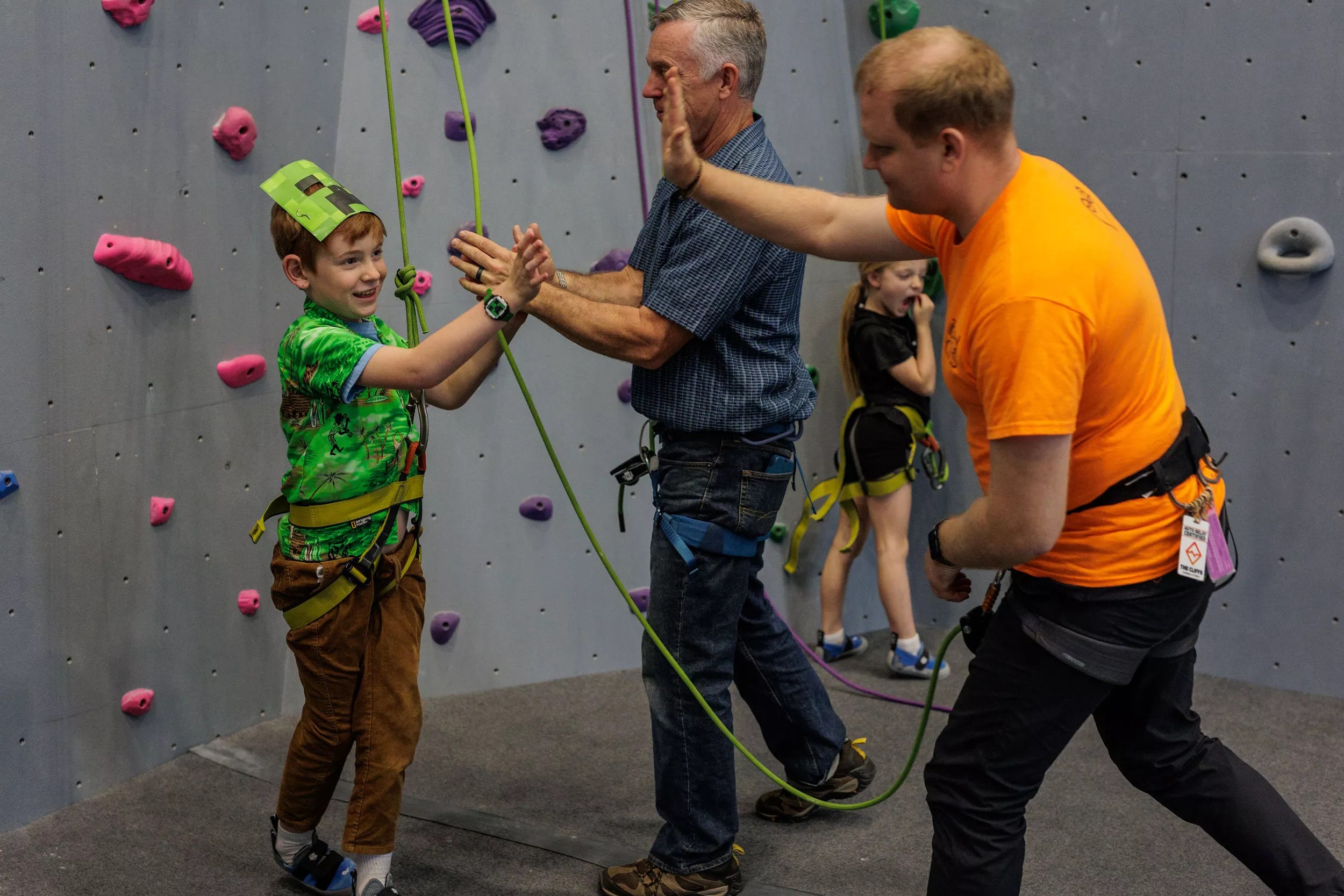
Gabriel McCormick, 9, is congratulated on his completed climb by his father Mark (center) and volunteer Kirill Vostrikov.
Nathan Hunsinger
A Climbing Community
Rock climbing’s positive effects continue to be studied. In one study, 9-year-olds with ADHD spent nine months in a rock climbing program. After the program, participants experienced a significant decrease in resting heart rate and increases in duration of breath holding, flexibility, balance, discipline, independence and persistence.
Rock climbing has also been shown to improve handgrip strength in children with autism, who tend to have weaker handgrip strength than neurotypical children.
Prescribed exercise programs have also been shown to improve physical and mental development in people with Down syndrome, who are predisposed to reduced bone mineral density and increased risk of fracture. In an eight-week exercise program for adults with Down syndrome, participants significantly improved their physical and cognitive health and enhanced their decision making and critical thinking.
“Trust, balance, focus, problem solving, confidence. There’s so many benefits [from rock climbing], it’s just crazy,” Mariana says.
The next step for United Rocks is bolstering their competition team. They have had a couple competitions already, with just three kids competing so far.
Not every kid is going to be able to compete. Most of them are just there for the fun and community at Sunday practices. But for the higher-level kids, competition can be a great way to earn accolades.
USA Climbing, the governing body over the climbing competitions, has a category for para-climbers with physical disabilities, such as amputees, but no special category for climbers with IDD. “That’s one of the things we’re working on, to add that category.” Special Olympics doesn’t offer climbing at all, something the Steelsmiths want to introduce.
United Rocks has had a profound impact on their son, Jake. “He’s loved all over the place, and he goes into practices, and everybody knows him. Everybody knows who he is, and he just hugs everybody.”
Seeing Jake accepted in the community while developing his rock climbing skills has been an emotional experience for Mariana, who worried Jake would lack the opportunities Gabriel had.
On this day at Dyno-Rock, Jake decided not to climb. His focus was fastened to the shredded rubber mulch that makes up the soft ground below the walls.
“Everybody hates it, but the kids love it,” Mariana had whispered to me about the floor. “If you get in there, once you get out, your hands will be all black, and everything is black.”
Jake’s not fussy about the mess. What 6-year-old is? He shovels the rubber into a big bucket and laughs.
“Do you like to shovel, Jake?”
“Yes!” A big smile paints his face.
60 Minutes recently aired a segment on a climbing camp in the Austrian Alps that is helping grieving Ukrainian widows and their children who have lost fathers in the war recover their inner strength by overcoming physical challenges. Led by Nathan Schmidt, a lieutenant colonel in the U.S. Marine Corps Reserve, the retreat teaches community, courage and responsibility. “When you’re on the rope,” he said, “you’re responsible for those that are on the rope with you. When they’re weak, you pull them up.”
Brian echoed a similar sentiment. “This sport has to have community behind it, because it takes two people to do it, minimum.”
It seems there’s something special about the rock-climbing community that makes this work. Every person I know who rock climbs is always trying to get me to come try. Something about the sport hooks people in, making them want to share the experience with others. Recreational climbers tend to be more conscientious than other athletes, according to one study. Climbing is not just an activity, but a badge worn by those with similar values.
“That kind of community involvement, it’s not our normal way of being here in this country,” Brian says. “We don’t operate that way.”
“Holy moly,” Mariana interrupts, walking up to Brian and me and noticing the full page of notes on my pad. “Is he burning your ear already?”
“I’m trying not to cry every time I say something,” Brian responds.
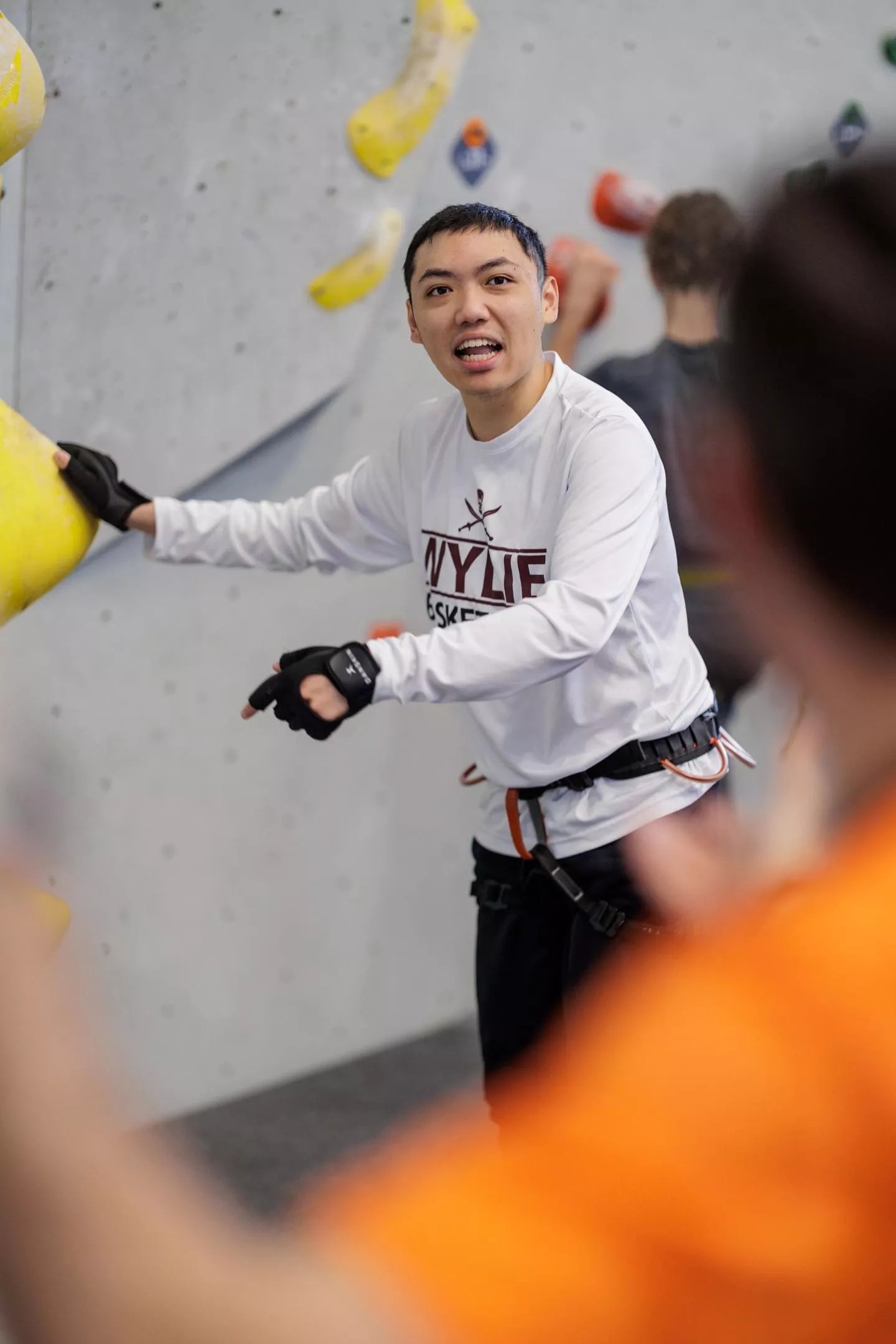
Adam Moua, 24, considers his climbing strategy.
Nathan Hunsinger
‘Get on the Wall’
Brian doesn’t stop at getting kids to climb. He wants parents on the wall. He points to Zaid’s father, Sami Kilani, who is watching his son from a bench. “He’s afraid of heights. He’s shy and not thoroughly interested. I will have him climbing though. The reason I’ll have him climbing is because if parents climb, the kids will follow.”
Zaid, who is 8 years old with low-spectrum autism and attention struggles, has tried other sports such as karate, soccer, basketball and swimming, but he hasn’t engaged with any of them.
Zaid goes up and down the wall just fine. He likes the shapes and colors of the holds. But his real passion lies in the chalk.
“Chalk!” Zaid yells, running around the soft ground, clapping his hands to make a white cloud of the powder that helps climbers grip the holds. He imagines a monster coming up from the ground through the rubber mulch whose only weakness is chalk. Chalk!
“Chalk is for the wall, remember?” volunteer Reed Clanton reminds him. Reed feels he can see things in the kids that he went through in his own life, himself having ADHD and autism. He works well with Zaid, knowing when to push the kid and when to play along.
Brian had already gotten through to one father about climbing that same day. Jeff Miller was there with his son Simon for their first time at practice. Already, there Jeff was, donning climbing shoes for the first time ever and giving the wall a conservative effort. “Didn’t get as high as Simon, I don’t think,” he says. “But as long as he gets into it, I’ll keep coming.”
At the end of practice, Reed gets a commitment from Sami that he will try climbing next week. He writes it down on Zaid’s chart to make sure to hold him to his word. “That’s really huge,” says Brian. “I’ve been bugging him since day one to get up on the wall. If dad’s climbing, the son’s going to climb too. And he is not a climber.” “Make sure you’re encouraging him too!” adds Katie.
Father-son climbing is a cornerstone for Greg Evans and his son Ian. Today, they find a red route to climb, the fourth easiest of the 11 color-denoted difficulty levels. Ian is a fast climber, barely looking down at his belaying dad as he “sends the route”: climber-speak for getting to the top.
Greg and the Evans family weren’t climbers before United Rocks. “It’s now a family thing,” Greg says, who also climbs with his daughter, a student at UT Dallas. The Evans are drawn to the community aspect of the sport. Sarah, Greg’s wife and Ian’s mom, is United Rocks’ gym manager and helps coordinate gym schedules and behind-the-scenes management.
“Eventually we want to go everywhere. Every gym that has a top rope in the U.S., we want to have a team there.” – Mariana Steelsmith, United Rocks
Some days, Ian, who has autism, is very communicative about what he wants to do next and when he needs a break. But when he’s not, Greg can still read clues in his son’s body language.
When Ian belays back down, he quickly grabs his Optimus Prime Transformers toy and goes to take a break on the couch. That means he’s done for now.
The volunteer-climber relationship is an important one that grows each week. If a kid takes to a volunteer, they’re going to look for them every time, Brian says.
Volunteer coordinator Kevin Cuadrado pairs himself with Jonah (a different Jonah from the Shaffstall son). They usually climb together, and Kevin has seen a lot of growth from Jonah over the months.
“He used to not even want to get on the wall,” says Kevin. Now, Jonah, a small 11-year-old with dark hair and an orange shirt, is tackling yellow routes, a step up from the beginner white routes.
He climbs fast, like Ian, racing with conviction toward the top of the route. Sometimes he gives into the temptation of putting his foot on a different color, making the route easier. But mostly, he stays true.
Jonah is a quiet kid but is comfortable talking to Kevin after forming trust over time. If you ask Jonah if he likes climbing, he’ll shake his head yes.
When Jonah is not in a talkative mood, Kevin picks up on nonverbal cues to see how things are going. Is he tired? Does he want to stop? Does he want to push himself today? “You have to try to figure out by the way that they’re acting if they’re not communicating.” On the other side of the gym, Spencer, a 7-year-old girl, hangs on the wall. “You got it, Spence,” yells her dad, Brandon Medley, from below.
“Good job!” encourages Kono Gadt, a volunteer who works with Spencer often. Spencer pushes off the wall and swings freely, clapping her hands, before pushing off the wall again and repeating the ritual. It’s a habit of hers, a mid-air respite.
“Get on the wall,” Brandon advises.
“Focus,” her mom, Alexandria, adds.
Her parents watch closely as Spencer regains her focus and climbs a bit higher on the white beginner route. She continues this way, taking breaks to swing before continuing up. Coach Sadie comes over to check on things and climbs up the wall a bit to offer advice.
Spencer reaches for worms – pink, green, blue – and drops them to the floor. Her parents and Gadt cheer her on.
Like Kevin and Jonah, Gadt and Spencer have forged a special relationship. “It’s fun watching her figure out the route,” Gadt says. “Other people might think she’s just swinging, but I can tell she’s working it out.”
“Did you have fun, Spencer?”
“Yeah,” she says, quietly.
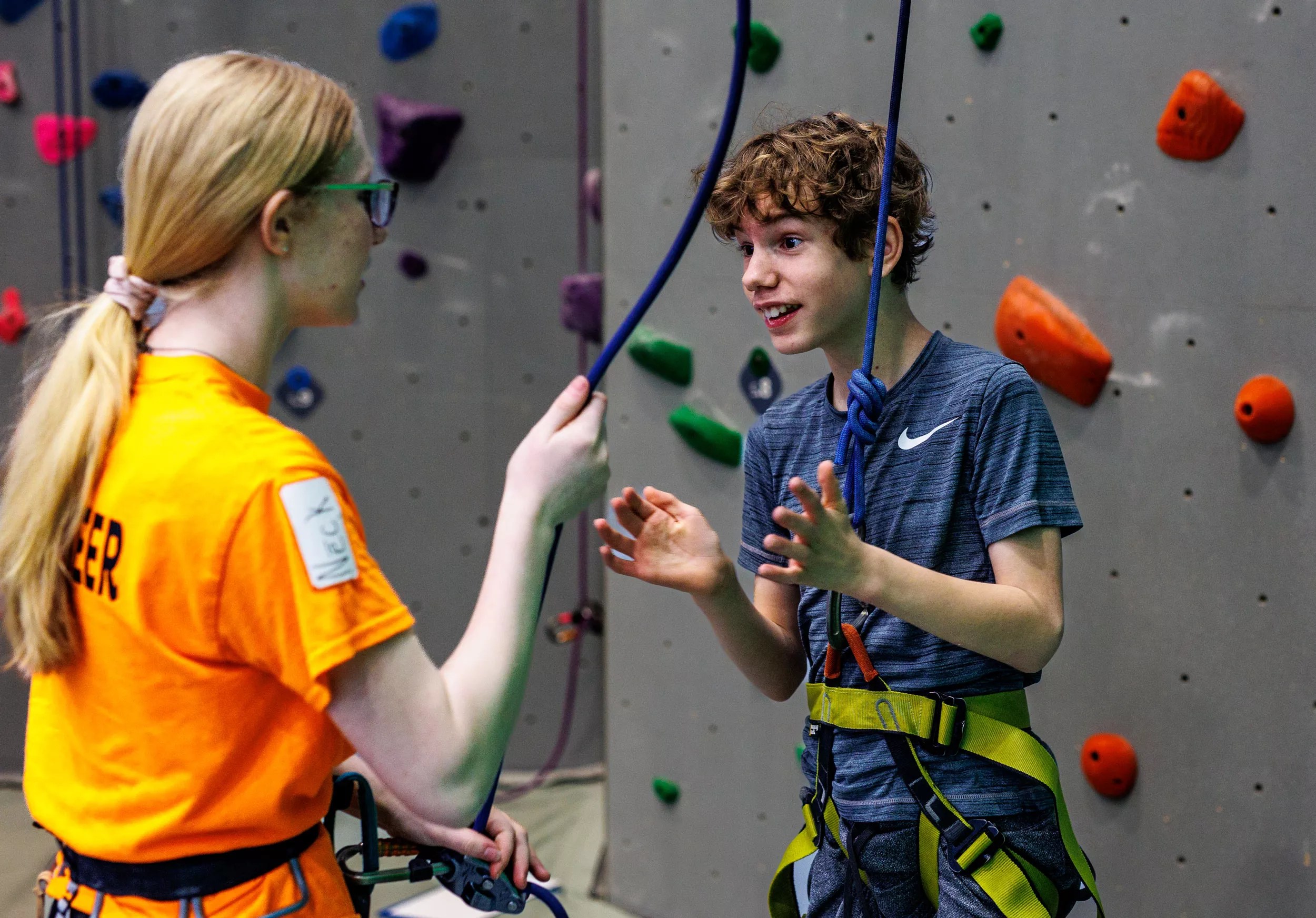
Volunteer Carrington Woods sings “Shake it Off” with Wes Chadwick.
Nathan Hunsinger
Excel, Not Struggle
Watching Jonah and Jacob climb and laugh at the Grapevine gym, knowing they lost their home to a fire just days before made for a remarkable sight.
Both brothers have autism. People with autism can be particularly resistant to change, clinging to routines like climbers on a wall. Anyone, kid or adult, special needs or neurotypical, would struggle with losing their home. But their mom seemed impressed with how her kids were adapting to the extreme circumstances. “The kids are doing well. They’re adjusting to a new routine, but we’re getting through.”
Amanda Shaffstall, a speech pathologist, woke up to the fire alarm at 2:30 in the morning. Her husband, Matt, was away hunting at the time. She opened the bedroom door to see a fire engulfing the pantry, the only room with a fire extinguisher besides the garage, which was blocked by the blaze.
She got Jonah and Jacob out of the house and into the car with their dog and a few necessities before the firefighters arrived.
The heat from the fire popped out drywall screws throughout the whole house. Even upstairs, where the flames didn’t spread, the heat melted light switches and blinds. They will be able to recover items made of textiles, like clothes, but not plastic. “A lot of kids’ toys are made of plastic.”
Amanda tried to salvage some of Jonah’s Legos, but even after six washes the smell of smoke and soot was still prevalent. “Basically, all of their toys were non-salvageable. And then most of their books. Everything but stuffed animals, basically.”
Five months since the fire, the family is still in a rental house in a neighborhood adjacent to where they lived in Northlake. Right now, the boys are taking a break from United Rocks as Jonah adjusts to a busy Applied Behavior Analysis therapy schedule, but they plan to go back once life quiets down. The house has to be rebuilt down to the studs, and the process has been slow.
Sometimes the kids ask about the old house. “We told them they can’t go in there because it’s too dirty,” Amanda says. Jonah will start fussing at her sometimes, saying, “You need to go clean the other house!”
“Well,” Amanda laughs, “it’s not that easy.”
The Shaffstalls were thankful that week for an escape from their suddenly chaotic lives to climb and be with friends. “My two kids, we don’t get to do what some of our other friends do and get to go to a soccer game or a football game or gymnastics,” Amanda says. It can feel isolating for her kids to struggle in activities, trying to keep up with their peers. “Having an activity that you can watch them excel in, instead of struggle with or not be able to be accessible at all, is very exciting.”
That week, the Shaffstalls looked to United Rocks as the one part of their routine they could control. The boys were pulled from their beds in the middle of the night without notice. Their home became unlivable in a matter of moments. But on Sunday at 10 a.m., they knew where they’d be.